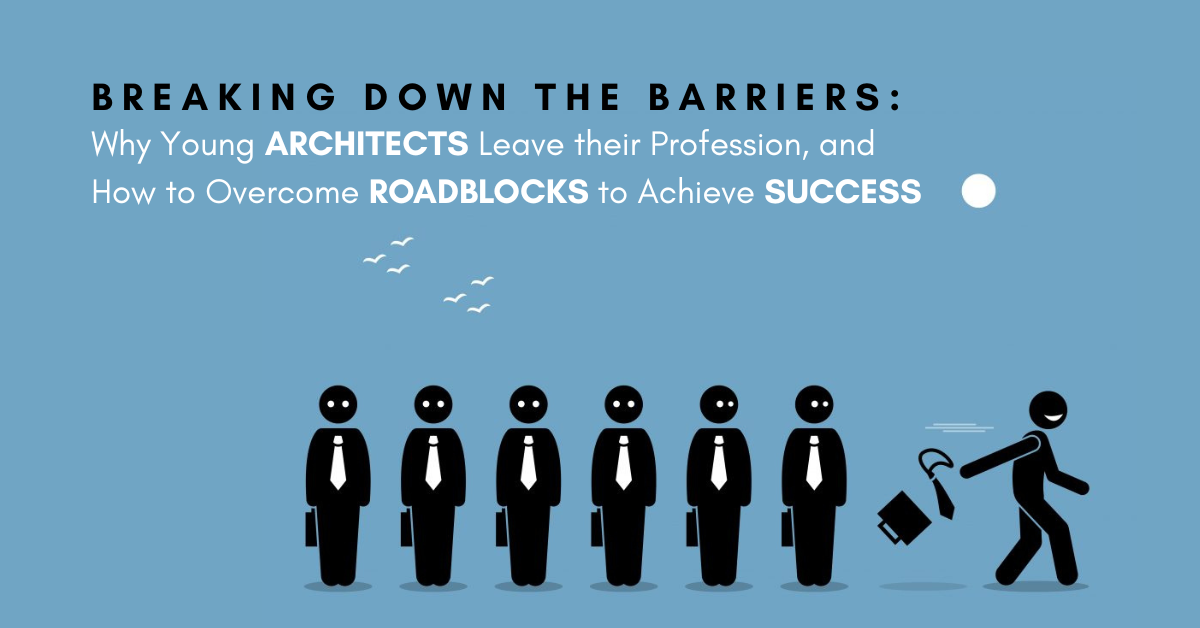
Why do Young Architects leave their Profession? How Architects Can Overcome the Challenges and Roadblocks to Success
There are several reasons why young architects leave the profession. One of the primary reasons is a lack of opportunities for growth and advancement within their firms. Young architects often enter the profession with high aspirations and creative energy, but find that they are given limited responsibilities and opportunities to work on meaningful projects. Additionally, long working hours, low salaries, and a lack of work-life balance can lead to burnout and disillusionment with the profession.
Another reason young architects leave is due to the highly competitive nature of the industry, which can make it difficult to find stable employment or build a successful career. Many architects also face barriers to entry, such as the high cost of education and licensing requirements, which can be prohibitive for those from disadvantaged backgrounds.
There are several reasons why young architects might leave the profession, including:
1. Burnout: Architecture is a demanding field that can be both mentally and physically taxing. Long hours, tight deadlines, and challenging projects can contribute to burnout and job dissatisfaction among young architects.

2. Lack of creative freedom: Architects often work in a highly structured and regulated environment, which can limit their creative freedom. Young architects may feel frustrated with the constraints placed on their designs and may seek out other careers that offer more opportunities for creativity.

3. Work-life balance: Architecture is a demanding field that can require long hours and significant time and energy outside of work. This can make it difficult for young architects to achieve a healthy work-life balance, leading some to seek out other careers that offer more flexible hours or better job-life balance.

4. Limited career advancement opportunities: Some young architects may feel that there are limited opportunities for career advancement within the profession, particularly in smaller firms. They may feel that they are stuck in entry-level positions with little chance of progression.

5. Low salaries: Architects often earn lower salaries than other professionals with similar levels of education and experience, particularly in the early stages of their careers. This can be a deterrent for some young architects who are looking for higher-paying careers.
6. Competition for work: Architecture is a highly competitive field, and there is often limited work available for young architects, particularly in certain regions or markets. This can make it difficult for young architects to establish a sustainable career in the field.
7. Dissatisfaction with the field: Some young architects may simply feel that architecture is not the right fit for them. They may find that they are not fulfilled by the work, or they may feel that the field is not aligned with their personal or professional goals.
In conclusion, there are many factors that can contribute to young architects leaving the profession, and it’s important for firms and organizations to understand these challenges and work to address them. By creating a supportive work environment, providing opportunities for growth and development, and offering competitive salaries and benefits, firms and organizations can help retain young architects and support their success in the field.
How Architects can Overcome the Challenges and Roadblocks to Success by Taking the Following Steps:
1. Continuously improve their skills: Architects should be proactive about seeking out opportunities to improve their skills, such as attending workshops, taking online courses, and seeking mentorship from experienced architects. By continuously developing their skills, architects can stay ahead of the curve and remain competitive in the field.
2. Build a strong network: Networking is key in the architecture profession. Architects should seek out opportunities to connect with other professionals, attend industry events, and participate in professional organizations. Building a strong network can help architects stay informed about industry trends, find new job opportunities, and access resources and support.
3. Pursue a diverse range of projects: Architects can benefit from working on a diverse range of projects that challenge their skills and provide opportunities to develop new areas of expertise. By working on a variety of projects, architects can gain a more well-rounded perspective on the profession and build a more diverse portfolio.
4. Stay up-to-date with technology: Technology is constantly changing in the architecture field, and architects must stay up-to-date with the latest tools and software. By utilizing technology effectively, architects can improve their efficiency and accuracy, and remain competitive in the field.
5. Balance work and life: Architects must prioritize their health and well-being to avoid burnout. They should strive to maintain a healthy work-life balance, by setting boundaries and taking time for self-care and leisure activities.
6. Seek out mentorship: Young architects can benefit from seeking out mentorship from experienced professionals. By having a mentor, architects can receive guidance, advice, and support as they navigate their careers.
7. Stay positive and persistent: Finally, architects must remain positive and persistent in their careers, even in the face of challenges and roadblocks. By focusing on their goals and maintaining a positive attitude, architects can stay motivated and achieve success in the field.
In conclusion, there are many challenges that architects face in their careers, but by taking the steps outlined above, architects can overcome these challenges and achieve success in the field. By continuously improving their skills, building a strong network, seeking out mentorship, and staying up-to-date with technology, architects can position themselves for success and fulfillment in their careers.
If you’ve any queries related to furniture, Click here to Book An Appointment or Talk to Our Expert.








